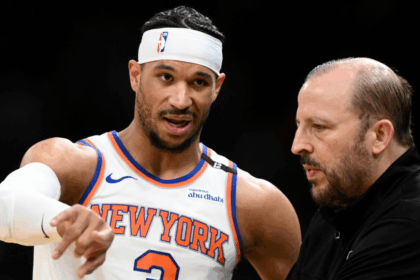The Golden State Warriors’ strong 4-1 start has vanished as they’ve gone 5-7 over their last 12 games, struggling offensively despite having Stephen Curry on the roster. Following a loss to the Oklahoma City Thunder on November 11, Draymond Green and Jimmy Butler used the media to send a pointed message. Green expressed that while everyone seemed determined to win early in the season, that focus appears lost now. He also hinted that personal agendas should align with team goals, or else players might be forced out, although he claimed not to target anyone specifically, which many believe wasn’t true. His comments suggested criticism of the younger Warriors, especially Jonathan Kuminga.
Reportedly, Kuminga felt unfairly blamed once again, having been portrayed over the past two years as a problematic and disruptive force within the team. While not perfect, Kuminga had been striving to contribute properly early in the season, earning a starting role from coach Steve Kerr. However, after some inconsistent performances and injuries, he was benched in favor of rookies Will Richardson and Moses Moody, and has missed the last four games due to injury. The Warriors have since won a few games without him, leading to whispers that the team is better off without Kuminga, though these outcomes were largely driven by Stephen Curry’s outstanding scoring. The Warriors still lack a clear and consistent strategy to beat top teams, relying heavily on Curry.
Beyond Kuminga, the Warriors face broader roster issues. They are notably undersized and struggle with rebounding and defense, keeping their defensive rank artificially bolstered by weaker opponents. Several key players have shooting limitations, including Al Horford, Gary Payton II, Buddy Hield, and Draymond Green, who is shooting just 38% from the field. Turnovers are also a significant problem. Kuminga, while not a scapegoat, is also not seen as the ultimate solution. His style clashes with the team’s needs—Green and Butler require reliable shooters around them, but Kuminga is inconsistent as a shooter and his aggressive offense doesn’t always fit the Warriors’ system.
The Warriors are grappling with balancing a flawed but energetic group of players, aiming to blend their strengths to find success. This juggling act has proven difficult, and the team’s current .500 record reflects this struggle. Trade rumors suggest Kuminga could be moved before the deadline, seen by some executives as a valuable asset. However, despite the turmoil, the Warriors still have championship potential with leaders like Curry and Green, provided they make necessary adjustments.
In summary, the Warriors’ underlying problems are a full roster issue, not the fault of one young player. The team needs accountability from its veteran stars and a clear approach to integrating its younger, developing talent. Until that happens, the Warriors will continue to underperform relative to expectations.
Fan Take: This situation highlights the complexity of managing star power alongside emerging talent in a championship contender. For basketball fans, it underscores how critical balance and chemistry are in building a winning team, not just having big names on the roster.



